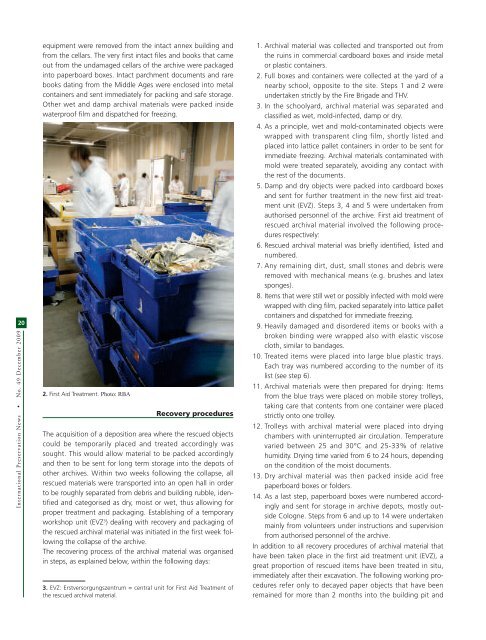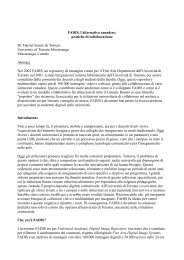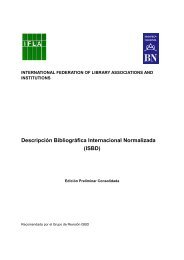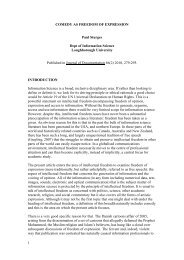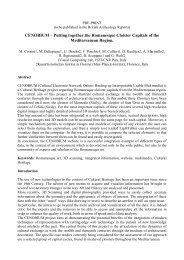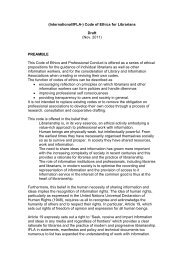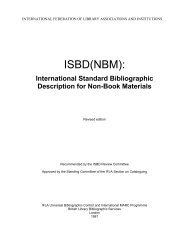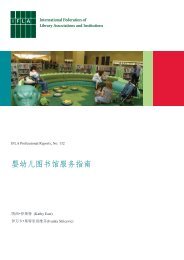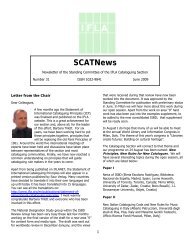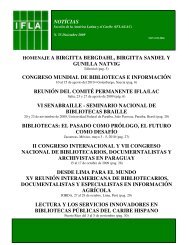No 49 - IFLA
No 49 - IFLA
No 49 - IFLA
Create successful ePaper yourself
Turn your PDF publications into a flip-book with our unique Google optimized e-Paper software.
20<br />
International Preservation News <strong>No</strong>. <strong>49</strong> December 2009<br />
equipment were removed from the intact annex building and<br />
from the cellars. The very first intact files and books that came<br />
out from the undamaged cellars of the archive were packaged<br />
into paperboard boxes. Intact parchment documents and rare<br />
books dating from the Middle Ages were enclosed into metal<br />
containers and sent immediately for packing and safe storage.<br />
Other wet and damp archival materials were packed inside<br />
waterproof film and dispatched for freezing.<br />
2. First Aid Treatment. Photo: RBA<br />
Recovery procedures<br />
The acquisition of a deposition area where the rescued objects<br />
could be temporarily placed and treated accordingly was<br />
sought. This would allow material to be packed accordingly<br />
and then to be sent for long term storage into the depots of<br />
other archives. Within two weeks following the collapse, all<br />
rescued materials were transported into an open hall in order<br />
to be roughly separated from debris and building rubble, identified<br />
and categorised as dry, moist or wet, thus allowing for<br />
proper treatment and packaging. Establishing of a temporary<br />
workshop unit (EVZ 3 ) dealing with recovery and packaging of<br />
the rescued archival material was initiated in the first week following<br />
the collapse of the archive.<br />
The recovering process of the archival material was organised<br />
in steps, as explained below, within the following days:<br />
3. EVZ: Erstversorgungszentrum = central unit for First Aid Treatment of<br />
the rescued archival material.<br />
1. Archival material was collected and transported out from<br />
the ruins in commercial cardboard boxes and inside metal<br />
or plastic containers.<br />
2. Full boxes and containers were collected at the yard of a<br />
nearby school, opposite to the site. Steps 1 and 2 were<br />
undertaken strictly by the Fire Brigade and THV.<br />
3. In the schoolyard, archival material was separated and<br />
classified as wet, mold-infected, damp or dry.<br />
4. As a principle, wet and mold-contaminated objects were<br />
wrapped with transparent cling film, shortly listed and<br />
placed into lattice pallet containers in order to be sent for<br />
immediate freezing. Archival materials contaminated with<br />
mold were treated separately, avoiding any contact with<br />
the rest of the documents.<br />
5. Damp and dry objects were packed into cardboard boxes<br />
and sent for further treatment in the new first aid treatment<br />
unit (EVZ). Steps 3, 4 and 5 were undertaken from<br />
authorised personnel of the archive. First aid treatment of<br />
rescued archival material involved the following procedures<br />
respectively:<br />
6. Rescued archival material was briefly identified, listed and<br />
numbered.<br />
7. Any remaining dirt, dust, small stones and debris were<br />
removed with mechanical means (e.g. brushes and latex<br />
sponges).<br />
8. Items that were still wet or possibly infected with mold were<br />
wrapped with cling film, packed separately into lattice pallet<br />
containers and dispatched for immediate freezing.<br />
9. Heavily damaged and disordered items or books with a<br />
broken binding were wrapped also with elastic viscose<br />
cloth, similar to bandages.<br />
10. Treated items were placed into large blue plastic trays.<br />
Each tray was numbered according to the number of its<br />
list (see step 6).<br />
11. Archival materials were then prepared for drying: Items<br />
from the blue trays were placed on mobile storey trolleys,<br />
taking care that contents from one container were placed<br />
strictly onto one trolley.<br />
12. Trolleys with archival material were placed into drying<br />
chambers with uninterrupted air circulation. Temperature<br />
varied between 25 and 30°C and 25-33% of relative<br />
humidity. Drying time varied from 6 to 24 hours, depending<br />
on the condition of the moist documents.<br />
13. Dry archival material was then packed inside acid free<br />
paperboard boxes or folders.<br />
14. As a last step, paperboard boxes were numbered accordingly<br />
and sent for storage in archive depots, mostly outside<br />
Cologne. Steps from 6 and up to 14 were undertaken<br />
mainly from volunteers under instructions and supervision<br />
from authorised personnel of the archive.<br />
In addition to all recovery procedures of archival material that<br />
have been taken place in the first aid treatment unit (EVZ), a<br />
great proportion of rescued items have been treated in situ,<br />
immediately after their excavation. The following working procedures<br />
refer only to decayed paper objects that have been<br />
remained for more than 2 months into the building pit and


